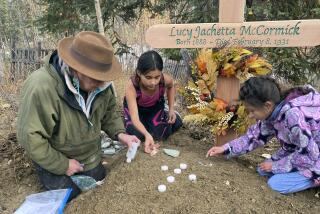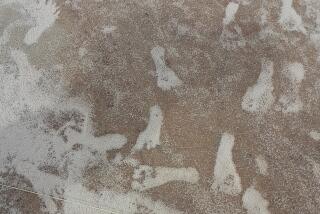Ancient child burial site found in Alaska
Alaska researchers have found the cremated remains of a 3-year-old child whose parents were among the first immigrants to North America, crossing over the then-existing land bridge from Asia to the New World through the region known as Beringia.
The 11,500-year-old remains were found buried on the banks of the Tanana River in the hearth of what appears to be a summer home for the early Beringians, the earliest known habitation for these first American settlers.
Archaeologists already know quite a bit about these early people based on sites where the groups gathered briefly to hunt, skin and consume large game, said archaeologist Frank E. âTedâ Goebel of the Center for the Study of the First Americans at Texas A&M University, who was not involved in the current research.
The new find, reported this week in the journal Science, will tell us much more about their lives, Goebel said â âwhat they were doing the 95% of the time they werenât out hunting, what the rest of their diet was composed of, how they survived in the very harsh climate of the Ice Age and how they dealt with people who passed away.â
Archaeologist Ben Potter of the University of Alaska Fairbanks and his colleagues have been working at the site since 2006, surveying it in advance of planned construction of a railroad bridge over the river. They found the child last summer. The siteâs name is Upward Sun River, a translation of the Athabaskan name Xaasaa Naâ. The child has been named Xaasaa Cheege Tsâeniin, or Upward Sun River Mouth Child, by the Healy Lake Native community.
The habitation appears to be a large, circular dwelling dug nearly a foot into the ground. The precise size is not clear because the excavation is not complete. The hearth in the center is oval-shaped and nearly two feet below the floor. In layers below the childâs remains are the bones of salmon, ground squirrels, ptarmigan and other small animals. The remains were radiocarbon-dated.
Only about 20% of the childâs bones remain. They were covered over and the hearth was not used again â the dwelling presumably abandoned.
The remains were laid out as though the child were placed to rest, but there was little evidence of any grave goods, which are often found at ancient burial sites. Researchers did find two pieces of red ochre, which is frequently used in burials, but the ochre has other uses as well, so its significance is not clear.
The fact that the parents buried the child in the house, which was the center of their activities, then abandoned the house, was indicative of the careful treatment they gave to the child, Potter said.
Stains on the floor of the house suggest that the walls were supported by wooden poles, but the researchers do not know the composition of the walls. The house appears to be much more similar to dwellings from the same time period found at Siberiaâs Ushki Lake than to anything found in the Lower 48 states.
The team hopes to obtain DNA from the childâs remaining bones, which would provide new insights into both where the Beringians came from and their relationship to the regionâs current residents. Members of the Healy Lake Native community have offered to donate their own DNA for comparison.
More to Read
Sign up for Essential California
The most important California stories and recommendations in your inbox every morning.
You may occasionally receive promotional content from the Los Angeles Times.










